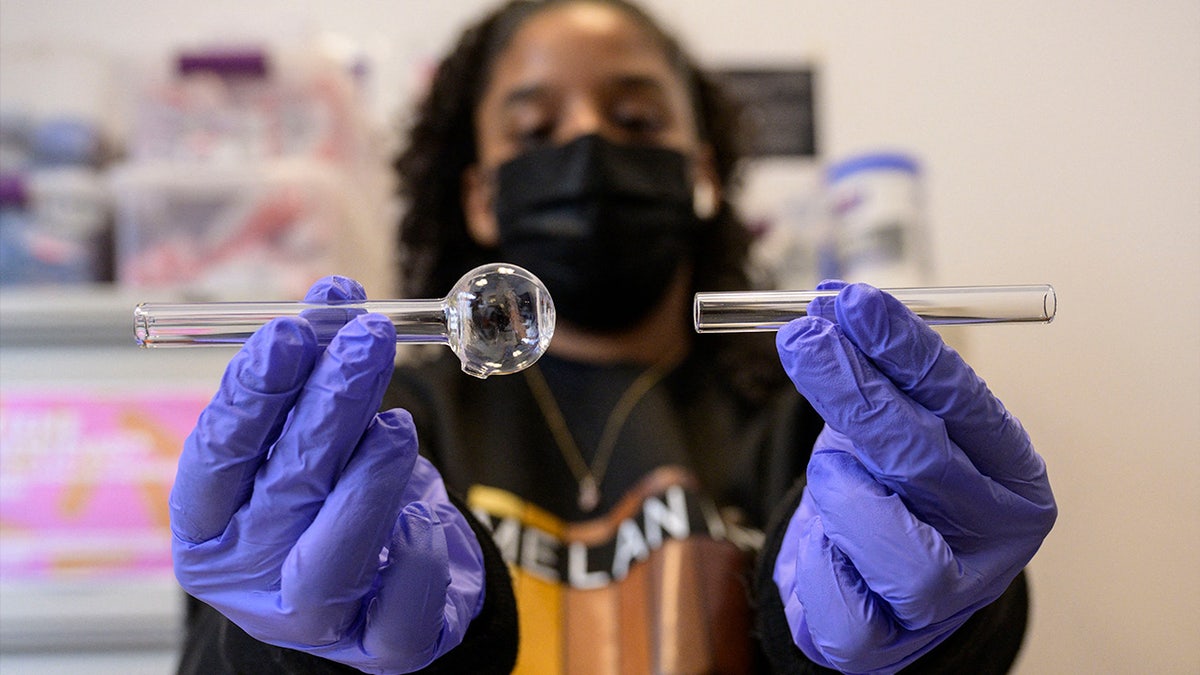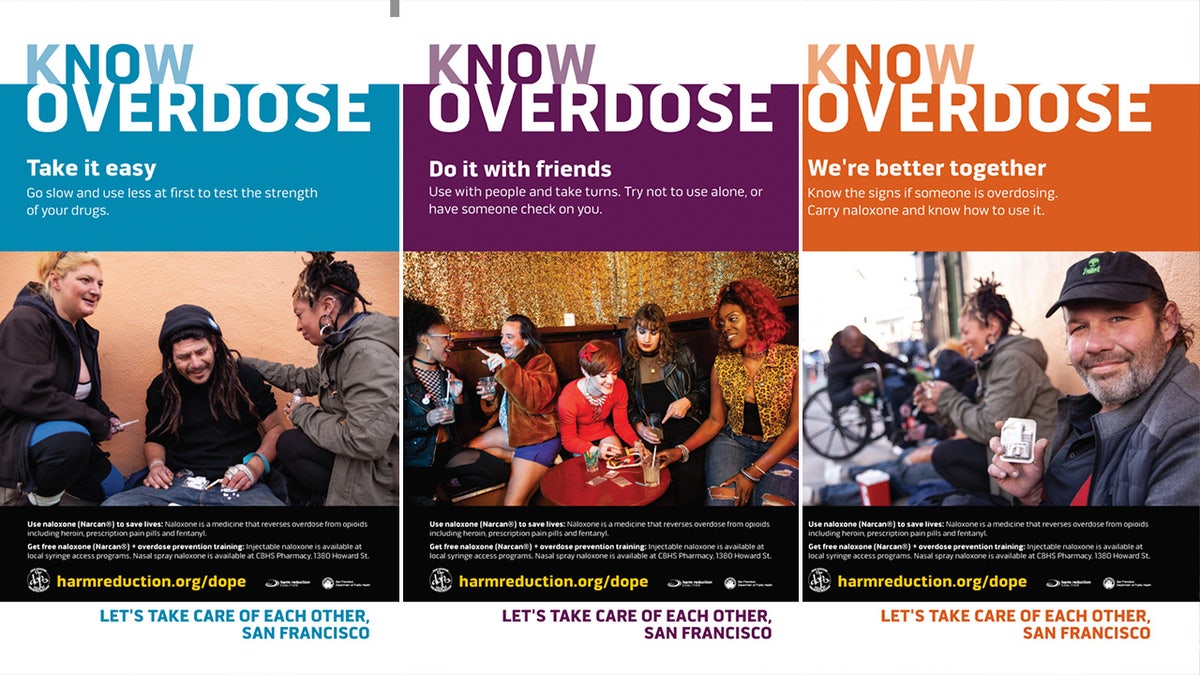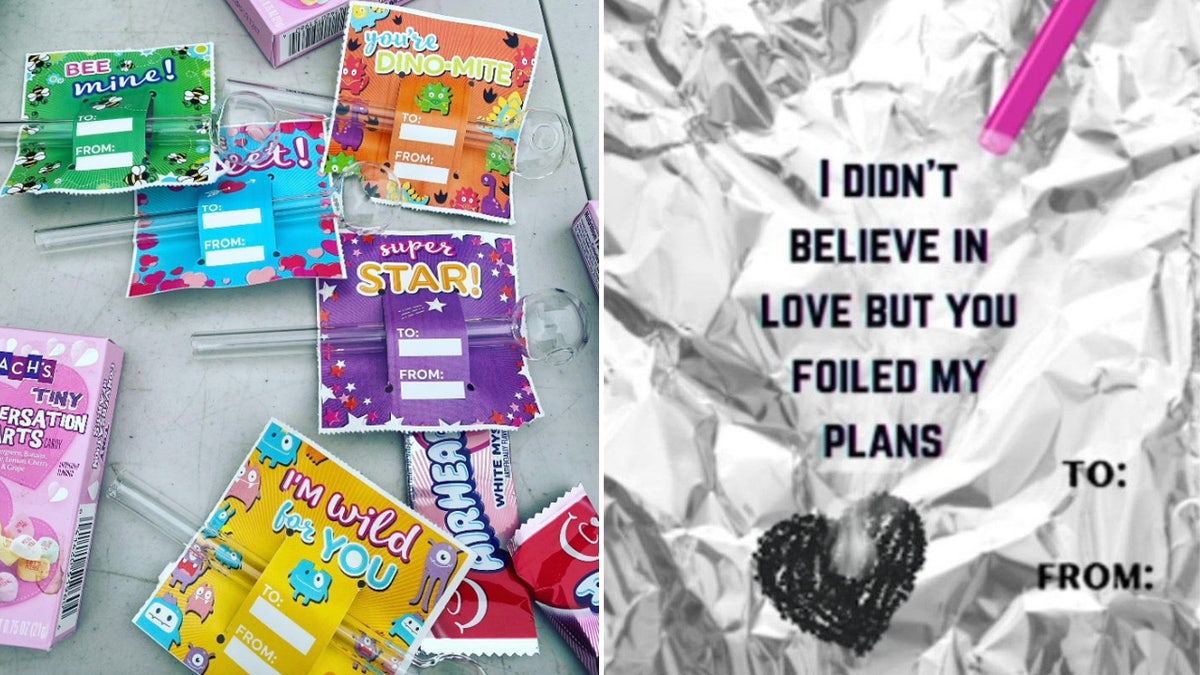Advocates claim these meth pipe valentines are helping drug users
Critics say billboards encouraging safe drug use and holiday cards with smoking pipes send a "terribly wrong message." But harm reduction advocates say they save lives.
Jose Martinez was jobless, homeless and stuck in what he calls the "chaotic part" of his drug use in 2015, after aging out of New York's foster care system seven years prior. Then staff at an overdose prevention site showed him kindness.
"'The universe is about give and take,'" he recalled staff telling him. "'So if you're going to be living your life, using drugs or doing whatever you want to do, do something that's going to uplift the community.' That message right there completely changed my life."
Martinez now works for the National Harm Reduction Coalition (NHRC), a national nonprofit promoting safer drug use. But skeptics argue harm reduction messaging has become increasingly dangerous, with billboards advising drug users to "do it with friends," nonprofits handing out meth pipes attached to Valentine's cards, and more.

A staff member holds up a glass pipe used to smoke drugs at St. Ann's Corner of Harm Reduction in New York City on April 24, 2023. (ANGELA WEISS/AFP via Getty Images)
FENTANYL PENALTIES COULD GET HARSHER IN THIS STATE WITH DECRIMINALIZED DRUGS
"I'm a drug and alcohol counselor," Portland-area activist Kevin Dahlgren told Fox News. "And the reason why I'm against harm reduction is because it's now changed to encouraging use."
"That is a line that should have never been crossed," he added.
Harm reduction is a strategy that meets drug users where they are, offering clean needles, naloxone to reverse an overdose and other supplies without pressuring people to enter treatment. Only one out of 10 people with a substance use disorder have received treatment, according to the Substance Abuse and Mental Health Services Administration, and most drug users don't think they have a problem.
Martinez said harm reduction was the "black sheep" of the public health field before gaining more acceptance in the last few years.
"Our approach was too radical for some folks," he said.
Martinez used to smoke K2, a synthetic cannabinoid also known as "spice." But he said the drug had him stealing from family, burning bridges and turned him into a "completely different person."
"But it was more my circumstance," Martinez quickly corrected. "It was not the drug because we believe that every drug can be used safely and recreationally even."
He stopped using K2, saying he’d "rather stick to weed." He went from living on the streets to living in his own apartment and working 40 hours a week. He attributes the positive changes to support from harm reduction proponents.
But on the other side of the country, San Francisco-based recovery advocate Tom Wolf had a very different experience.
‘A LINE THAT SHOULD HAVE NEVER BEEN CROSSED': ACTIVISTS SLAM HARM REDUCTION MESSAGING:
WATCH MORE FOX NEWS DIGITAL ORIGINALS HERE
Wolf was homeless on the streets of the Tenderloin neighborhood in early 2018, cycling in and out of jail. His sixth arrest in three-months landed him in custody long enough to get clean and reevaluate his life. He celebrated five years of sobriety in June, a milestone he doubts he would have reached without police intervention.
"The harm reduction mantra is that you should have bodily autonomy. You should be in control of whatever you put in your body, including drugs," Wolf said. "If you're in the privacy of your own home, I would kind of agree with that."
But his tolerance ends at public drug use.
"When you're doing it out on the street, in front of kids, in front of families, in front of businesses … that's not okay," he said. "Leaving someone in a tent on the street to do whatever they want is actually not body autonomy. That's actually cruel."
The debate over harm reduction messaging has intensified as overdose deaths skyrocket. More than 100,000 people died from a drug overdose in 2022, a 45% increase since 2019, according to Centers for Disease Control and Prevention data.
"We're not condoning drug use. We're not condemning it either," Martinez said, adding that harm reduction advocates focus on saving lives and preventing the spread of disease. "We just want folks to be safe so that they have tomorrow. You know, we don't know what tomorrow brings."
Wolf and Dahlgren said they support harm reduction when it comes to offering needle exchanges, but that more recent strategies like San Francisco's Know Overdose campaign go too far.
Led by NHRC's DOPE Project, billboards and posters plastered with the words "Know Overdose" featured tips like "do it with friends" and "take it easy," paired with photos of people at a party or homeless people smiling as they prepare to use drugs on the streets.

NHRC's DOPE Project released posters promoting safer drug use and naloxone in a partnership with the San Francisco Department of Health. The Know Overdose campaign came under fire in 2020 with critics accusing the city of encouraging addiction. (harmreduction.org via Wayback Machine)
DRUG ARRESTS PROVE THIS CITY IS A 'MAGNET' FOR HOMELESSNESS, CRIME, ACTIVIST SAYS
"I was an intravenous drug user. There's nothing happy about it," Wolf said. "It just sends this really terribly wrong message that this is okay, that we should accept this as a society and that this should become normalized. And I will not accept that."
Each poster also had information about where to get free naloxone to reverse overdoses.
Swift backlash followed, and Wolf said the city removed the billboards. The NHRC issued a statement expressing disappointment that the health department caved to pressure from members of the public to rescind its support for the campaign.
"Last year 2,601 overdoses were reversed with naloxone distributed by DOPE Project partner organizations," NHRC wrote in March 2020. "Imagine what the overdose rate might be without the program and without the work and love of the community we serve."
Martinez declined to comment on the San Francisco billboards.
Dahlgren also accused harm reduction organizations of marketing to adolescents.
"We're seeing these cute Valentine's cards and cartoon characters and fentanyl straw that become very colorful, that look like candy canes," he said. "It's no different than how they marketed candy cigarettes to kids in the 1980s."

The Seattle-based nonprofit People's Harm Reduction Alliance shares photos on Facebook of meth pipes attached to Valentine's Day cards and other cards with drug-related puns. (People's Harm Reduction Alliance/Facebook)
CASES OF MARIJUANA LACED WITH FENTANYL INCREASING, SAYS WASHINGTON DOCTOR
Dahlgren pointed to the Seattle-based People's Harm Reduction Alliance, which in 2022 shared an image of glass pipes attached to colorful Valentine's cards. This year, the nonprofit shared numerous Valentine cards on its Facebook page with puns like, "I didn't believe in love, but you foiled my plans" over an image of foil and a fentanyl straw. Another card is more straightforward, spelling out "End the drug war" with candy hearts.
"This is not marijuana," Dahlgren said. "This is fentanyl — 50 times stronger than heroin and cheaper. This is insane."
Martinez disputed that attaching cards to a pipe is encouraging drug use. Rather, he said it humanizes drug users and may bring them a glimmer of hope.
"These are people who don't got nobody," he said. "I've done events and we pass out Christmas cards with a pipe and a candy cane taped to it and you want to know what? They like, ‘Y’all doing the work of God.'"
Harm reduction efforts have received millions of dollars in Dahlgren's home state. Oregon voters passed Measure 110 in 2020, decriminalizing personal use amounts of all drugs and redirecting much of the state's marijuana tax revenue to fund grants for addiction services.
The largest number of clients accessing Measure 110-funded services in the second half of 2022 were in harm reduction, followed by peer support services, according to Oregon Health Authority data. More than $3.1 million in Measure 110 grants went to harm reduction.

A pipe for methamphetamine use is shown at the People's Harm Reduction Alliance in Seattle, Washington. (Reuters/David Ryder)
Nationally, NHRC received more than $8.4 million in government grants in 2021 — more than 80% of its total revenue that year, tax records show.
And People's Harm Reduction Alliance received some $1.3 million in grants and other funds in 2021, though it didn't indicate whether any of that came from taxpayers. Volunteers handed out nearly 4.3 million syringes and more than 12,500 naloxone kits that year.
The organization also gives drug users kits for smoking, snorting and boofing (ingesting drugs through the anus), clothes and hygiene products, and outdoor survival gear, according to its website.
"What we really need to focus on, in my opinion, is treatment," Wolf said. "And that's not necessarily what harm reduction focuses on."

People sleep near discarded clothing and used needles on a street in the Tenderloin neighborhood in San Francisco, on July 25, 2019. (AP Photo/Janie Har)
CLICK HERE TO GET THE FOX NEWS APP
Martinez disavowed the "us vs. them" mentality he sees between abstinence advocates and harm reduction proponents. If he meets clients he thinks would benefit from the structure of treatment, he says he "would definitely refer them" there.
"New approaches is needed," he said. "All we want as harm reduction is [for] people to look at our community members differently. They are human beings."






















